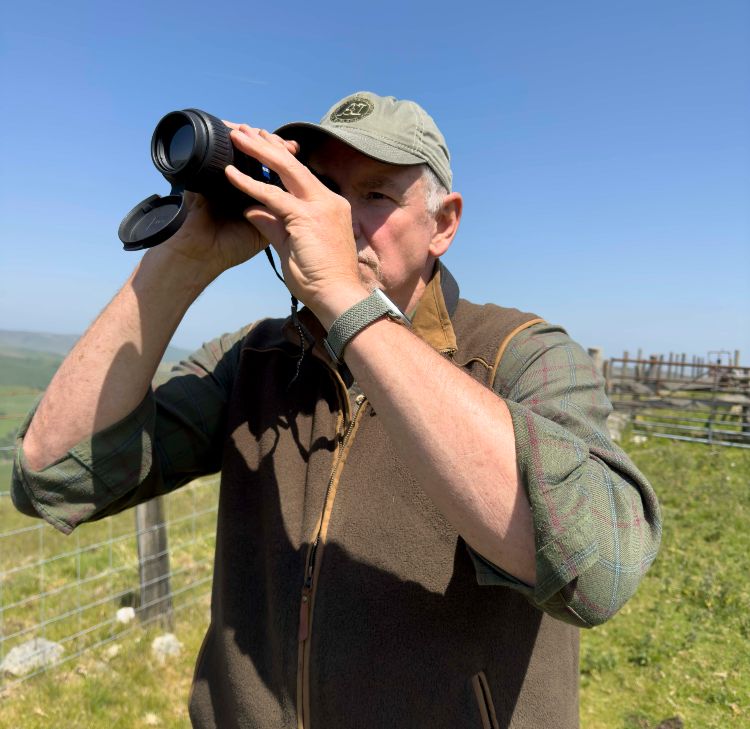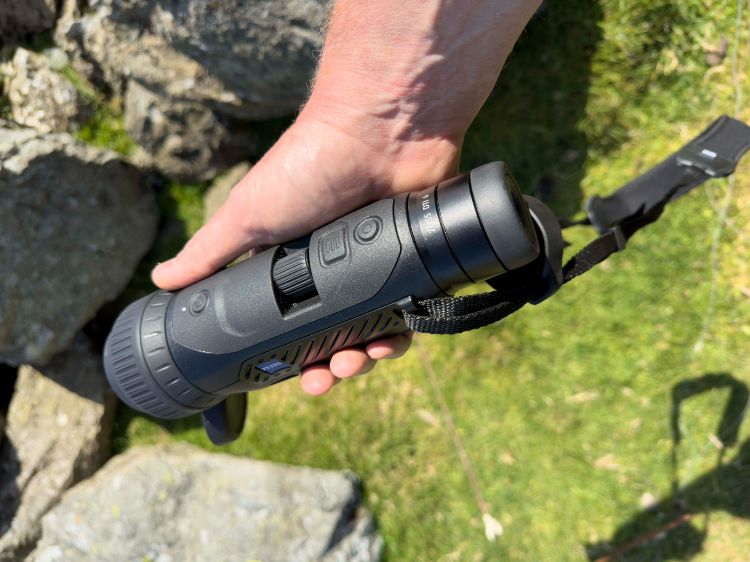From long-range hunting to woodland pursuits, the all-new DTI 6 thermal spotter from Zeiss offers plenty of flexibility to foxers and deer stalkers alike.
Renowned alpha glass manufacturers such as Zeiss have been relatively slow to jump into the thermal market. However, this stance shifted with the launch of the DTI 3, a thermal spotter showcasing superb ergonomics and a 384x288 sensor, not to mention Zeiss’s renowned build quality.
Now Zeiss returns with the DTI 6, a 640x480 12µm device promising a 2000m detection range, an f/1.0 lens, a 1024x768 AMOLED display, a zoom range from 3x to 30x, and a sub-40mK NETD, all driven by a new imaging algorithm. There’s also Bluetooth connectivity for the Zeiss Hunting app and the now ubiquitous video and image recording.
Although the specs aren’t revolutionary, Zeiss cleverly caters to a specific audience with a non-techie approach to the interface and core functionalities, setting the company apart in a thermal market brimming with cheaper alternatives.
 Long-range hunting
Long-range hunting
Zeiss’s DTI 6/40 aims for the niche of long-range hunting over open fields rather than trying to be a one-size-fits-all thermal device. Its base magnification of 3x, extending up in 10 increments, isn’t designed for woodland environments. In such circumstances, a 2x or 2.5x base magnification proves more effective, where field of view is a higher priority than long-range detection. Thus, the DTI 6/40 is ideal for highseat, open country and mountain hunting, leveraging Zeiss’s prowess in lens and optical quality.
Woodland hunting
Despite its specific target audience, Zeiss haven’t neglected the woodland hunter. Leveraging their expertise in camera lenses, they’ve applied their knowledge from traditional DSLRs and mirrorless cameras to their latest thermal device, offering interchangeable lenses. In seconds the DTI 6/40 can morph into the DTI 6/20.
The DTI 6 can be purchased in either configuration, and this ability to switch modes is a strong selling point. Yes, there’s an additional cost – the 20mm lens retails at £535, while the 40mm lens goes for £785 when sold separately – but this offers significant flexibility to the system. The DTI 6/40 has a field of view of 19m@100m at 3x, but the DTI6/20 extends this to 40m@100m, making it an optimal choice for woodland hunting.
 Design elements
Design elements
The device features typical Zeiss design elements, including a magnesium alloy body and excellent ergonomics. It’s quite hefty at 755g, but an included padded neck strap offsets the weight. The layout is straightforward with an extendable eyepiece for correct eye relief, although I preferred the enclosed eyepiece design of the earlier DTI 3.
The dioptre adjustment sits ahead of the eyepiece, followed by the main controls. These include buttons for toggling and activating picture and video recording, and for initiating the on-screen menu system. An unusual but effective scroll wheel adjusts the zoom, cycling directly back to 1x after it reaches the 10x maximum. The final button controls power up and standby.
Focus, Battery Life and Image
The focus adjustment can be a double-edged sword. It’s light and can easily be knocked out of focus, but it can be adjusted one-handed with practice. This is especially useful when balancing a rifle on a set of sticks.
The DTI 6/40’s power management is a real standout. Zeiss claims a 6.5-hour continuous runtime, which during testing proved an underestimate – I got eight hours or more of continuous use without needing standby. The device uses a replaceable DSLR-style battery pack, allowing extended hunting trips with just a couple of these. The only slight caveat is the lengthy charging time. A full recharge from flat takes all night and part of the next day. And without a charging cradle, only one battery can be charged at a time.

Image Quality
In terms of image quality, the DTI 6/40 holds its own among its 640x480 peers. However, it’s worth noting that the £4,250 price for a thermal device without a laser range finder is a major investment.
The menu system offers substantial customisation options, including multiple colour schemes and environmental modes. Surprisingly, the ‘Fog’ mode proved very effective during the peak of the recent heatwave.
Ultimately, if you’re in the market for a thermal device with ‘built-to-last’ quality, exceptional battery life and switchable lenses, the DTI 6/40 is worth serious consideration, providing your budget will allow.
Understanding DRI in thermal spotters
DRI Ranges: The detection, recognition and identification (DRI) ranges for the DTI 60/40 (based on the Johnson criteria) are as follows:
- Rabbit: Detection at 600m, recognition at 150m, identification at 75m.
- Person: Detection at 2111m, recognition at 527m, identification at 263m.
- Vehicle: Detection at 5111m, recognition at 1277m, identification at 638m.
The Johnson criteria are a model used in optics and thermal imaging to define the requirements for the resolution of an imaging system. The system was developed by John Johnson in the 1950s while working at the US Army’s Night Vision and Electronic Sensors Directorate (NVESD).
The criteria are based on the concept of ‘line pairs’ across the critical dimension of a target. A line pair refers to a dark line and a light line. Johnson proposed that for an observer to perform certain tasks – detection, recognition and identification (DRI) – a certain number of line pairs was required:
- Detection: The observer needs to determine whether any object is present in the field of view.
- Recognition: Determining the type or class of an object, if it’s a person, vehicle, aircraft, etc.
- Identification: Requires the observer to determine specific details, for example distinguishing between types of vehicles, animals, or identifying a specific person.
For thermal imaging, these criteria are used to define the capabilities of a thermal imaging system. They help to estimate the maximum range at which a thermal imaging device can detect, recognise or identify an object of a certain size, given the resolution of the device and the characteristics of the lens. This is often presented as the DRI range.
However, it’s important to note that Johnson’s criteria are a simplification and can be influenced by various factors such as the contrast, noise and specific characteristics of the imaging system. The criteria assume optimal conditions, and real-world performance can vary.
Tech specs
Focal length: 40mm
Aperture: f/1.0
Field of view at 100 m (yds): 19m (62ft)
Detection range: 2000m (2187yd)
Sensor resolution: 640x480 12µm
Display resolution: 1024x768
Display frame rate: 50 Hz
Display type: HD AMOLED
Optical magnification: 3x to 10x
Zoom steps: 0.1x to 1.0x
Weight: 755g
Runtime: 6.5 hours continuous
Wifi & Bluetooth: Zeiss Hunting app
Dimensions: 228x69x73mm
RRP: £4,250